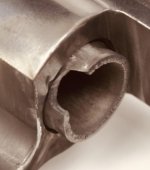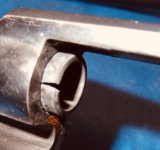Hand ejector damage
The early hand ejectors are often found damaged from smokeless use. The most common being a blown/ cracked forcing cone. Lady Smiths, 32's, and 38 special all suffered.
It was only one chapter of many that suffered during the transition to smokeless. The last photo is a beefed up forcing cone to correct the problem.
I mentioned in a previous post that early manuals sometimes listed too heavy a charge for the earlier guns. The photos show the most common damage. It took many years to correct the problems all amounting to strengthening the guns weak points.
Murph
The early hand ejectors are often found damaged from smokeless use. The most common being a blown/ cracked forcing cone. Lady Smiths, 32's, and 38 special all suffered.
It was only one chapter of many that suffered during the transition to smokeless. The last photo is a beefed up forcing cone to correct the problem.
I mentioned in a previous post that early manuals sometimes listed too heavy a charge for the earlier guns. The photos show the most common damage. It took many years to correct the problems all amounting to strengthening the guns weak points.
Murph
Attachments
Last edited:





